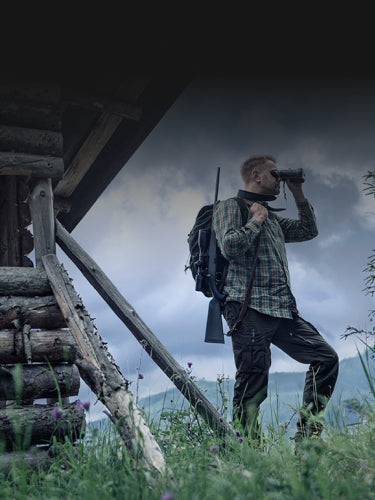One of the essential parts of a hunter’s toolkit besides his weapon is a good pair of thermal binoculars. Ideally used for stalking rather than stand hunting, where one will be able to spot an animal from a good distance away while remaining well out of its line of sight.
Now, while the human eye’s detection range is essentially infinite and limited only by terrain and the curvature of the earth, the further an object is, the more difficult it is to see, especially when the hunter is old or if the animal has good camouflage like this snow leopard camouflaged on a cliffside.

Thermal binoculars like the Pulsar Merger help immensely, defeating all manner of camouflage since they see the IR heat signatures emitted by all objects. However, like all tools, one must learn how to use it if one wants to be effective.
Stability and clarity of sight picture are important when glassing with a thermal, just like they are with regular daytime binoculars. Stability is easily achievable by using your binoculars with a sturdy hunting tripod like a Kopfjäger. The Merger LRF, when used with its mounting adapter, is perfectly compatible with the Kopfjäger leveling head, which allows the user to tilt and roll the binoculars without losing stability.

Of course, for hunters without a tripod, stability is still easily achievable from a sitting position by bracing one’s elbows on the knees, or from a standing position by bracing against the side of a tree trunk as one would with a rifle.
Slow, deliberate movements are essential for glassing. Movies and cartoons frequently depict characters rapidly moving from one area to another, but motion blur helps no one on a real hunting trip.
When glassing, it’s a generally bad idea to scan an area at random. For more efficient glassing, experienced hunters divide the landscape into grids. This is done by laying out one’s field of view into an imaginary series of vertical and horizontal lines like a chessboard. Slowly and carefully move the binoculars from left to right across your entire field of view, careful to look for any straight horizontal lines which might be the backs of deer or any movement that doesn’t seem like it’s just the wind. Once you reach the end of your field of view, shift your view either up or down and scan the next imaginary row right to left, as if you’re reading a grid.
While the binocular’s straps are for convenient access, there is a reason why they’re made to be slung around the neck and not stowed in a belt pouch. When a hunter is on the move and spots an object with his naked eye which he thinks might be an animal, he should not look down into his bag to take out his binoculars. He may lose his prey when he looks back up. Instead, hunters should lock their eyes onto their targets and bring up their binoculars from their chests so as to not lose their sight picture. This is similar to the concept of using magnifiers for red dots. The red dot stays on target but the magnifier does not need to adjust to magnify the same area.
Were these tips helpful to you? How do you use your Merger LRF thermal binoculars? Tell us in the comments below.
Frequently Asked Questions
1. How do thermal binoculars help with hunting?
Thermal binoculars detect IR heat signatures emitted by objects, making it easier to spot animals from a distance.
2. How can stability be achieved while using thermal binoculars?
Stability can be achieved by using a sturdy hunting tripod or bracing against a solid surface like a tree trunk.
3. Is scanning an area randomly effective when using thermal binoculars?
No, it's more efficient to divide the landscape into grids and scan methodically from left to right, then shift up or down and repeat.
4. Why should binoculars be slung around the neck instead of stowed in a pouch?
Keeping binoculars around the neck allows for quick access without losing sight of potential targets.
5. What is the importance of slow, deliberate movements while glassing with thermal binoculars?
Slow, deliberate movements help avoid motion blur and ensure a clear sight picture while scanning for animals.




